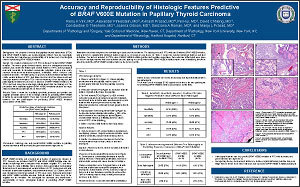Accuracy and Reproducibility of Histologic Features Predictive of BRAF V600E Mutation in Papillary Thyroid Carcinoma
Renu K Virk, MD1, Alexander Finkelstein, MD3, Avinash Prasad, MD4, Pei Hui, MD1, David Chhieng, MD1, Constantine G Theoharis, MD1, Joanna Gibson, MD1, Sanziana A Roman, MD2, and Manju L Prasad, MD1
Departments of 1Pathology and 2Surgery, Yale School of Medicine, New Haven, CT, Department of 3Pathology, New York University, New York, NY, and Department of 4Neurology, Hartford Hospital, Hartford, CT, USA
ABSTRACT
Background:
We proposed recently that papillary thyroid carcinomas (PTCs) with BRAF V600E mutation are morphologically distinct. Here we investigate the accuracy and interobserver reproducibility of a defined set of histological criteria in predicting BRAF V600E mutation.
Design:
We created a training set of 5 PTCs with and 5 without BRAF V600E mutation. The former group included classic, tall cell or subcapsular sclerosing variants, and showed well-developed nuclear features of PTC, tall or polygonal cells with moderate to abundant eosinophilic cytoplasm (plump pink cells), stromal fibrosis/sclerosis/desmoplasia, infiltrative tumor borders and psammoma bodies. The latter group, in general, included follicular variants with subtle nuclear features of PTC, and lacked most or all of the above mentioned histologic features of mutated PTCs. After self-learning on the training set, two pathologists predicted the presence or absence of BRAF V600E mutation in 30 PTCs (test set) using the morphologic criteria learnt from the training set. The predictions were evaluated against BRAF V600E mutational analysis by single strand conformation polymorphism on tumor DNA.
Results:
Table 1 shows the sensitivity, specificity, accuracy, and positive and negative predictive values of the histologic criteria for predicting BRAF V600E mutation by each pathologists. There was “excellent” (kappa 0.795) agreement between the two pathologists for predicting BRAF V600E mutation (concordance 27/30; 90%).
Conclusion:
Histology can help predict BRAF V600E mutation in papillary thyroid carcinomas with accuracy and good interobserver agreement.
©2012 Yale Department of Pathology. All rights reserved.
Any redistribution or reproduction of part or all of the contents in any form is prohibited. You may not, except with express written permission of the author or the Department of Pathology, distribute or commercially exploit the content, nor may you transmit it or store it in any other website or other form of electronic retrieval system, including use for educational purposes.
